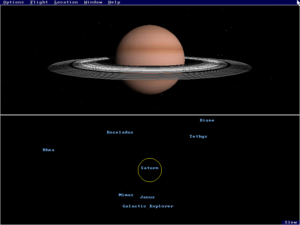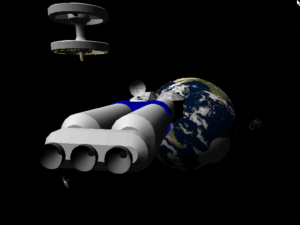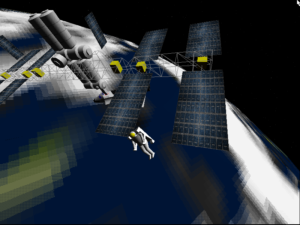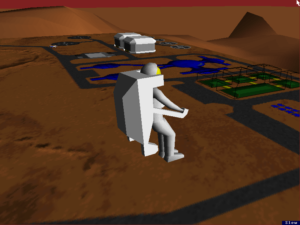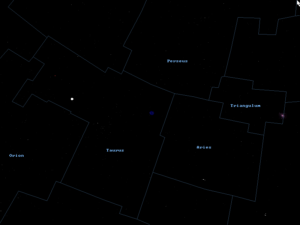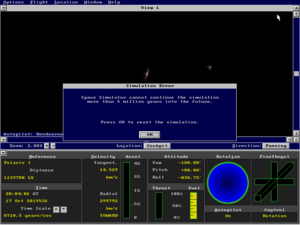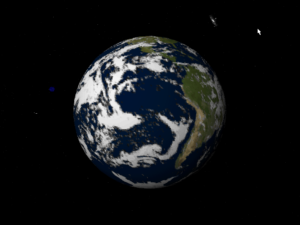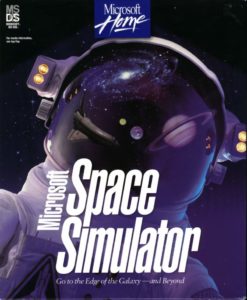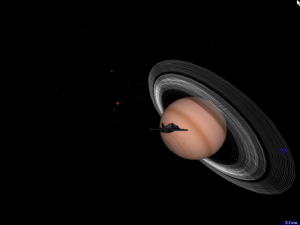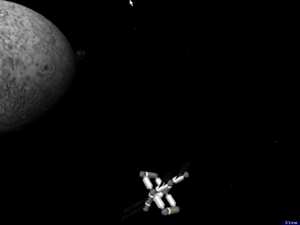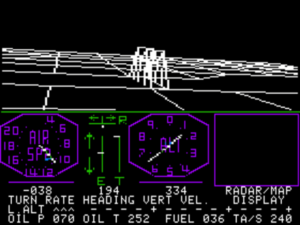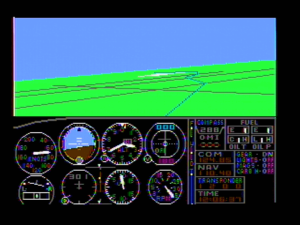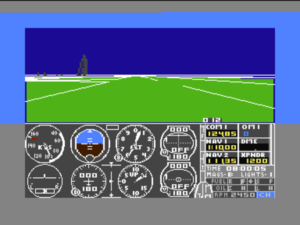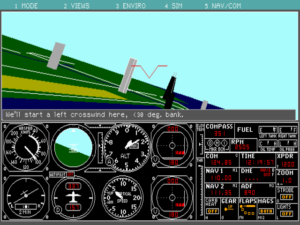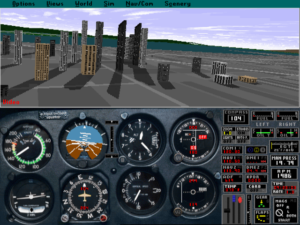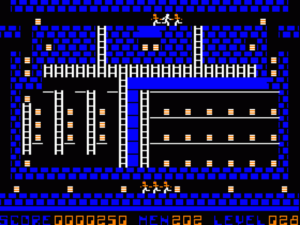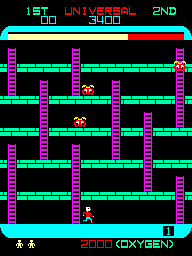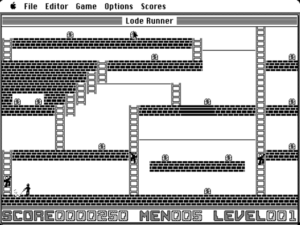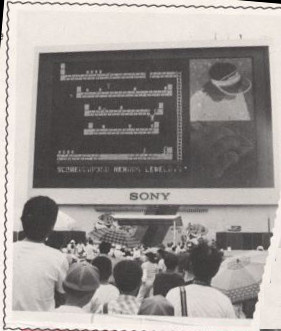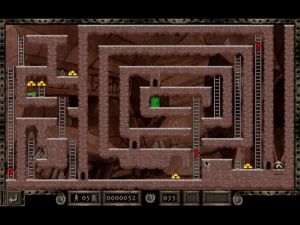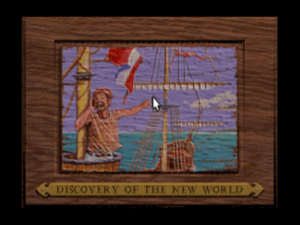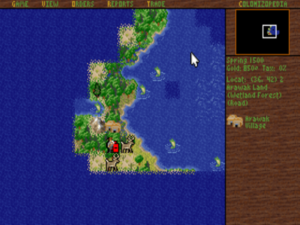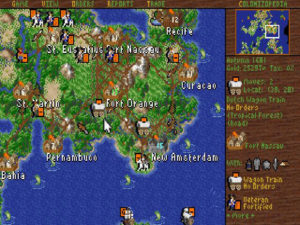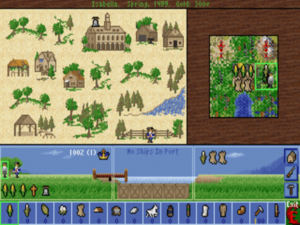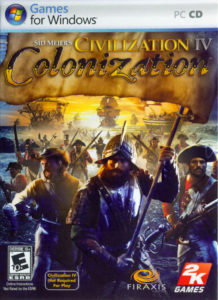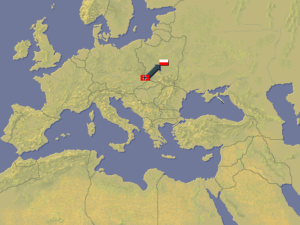
I apologize for liking German generals. I suppose I ought not to.
— Desmond Young
When I attempted to play the SSI computer game Panzer General as part of this ongoing journey through gaming history, I could recognize objectively that it was a fine game, perfectly in my wheelhouse in many ways, with its interesting but not overly fiddly mechanics, its clean and attractive aesthetic presentation, and the sense of unfolding narrative and personal identification that comes with embodying the role of a German general leading an army through the campaigns of World War II. But for all that, I just couldn’t enjoy it. When I conquered Poland, I didn’t feel any sense of martial pride; all I could see in my mind’s eye were the Warsaw ghettos and Auschwitz. I found I could take no pleasure in invading countries that had done nothing to my own — invasions that were preludes, as I knew all too well, to committing concerted genocide on a substantial portion of their populations. Simply put, I could take no pleasure from playing a Nazi.
So, Panzer General prompted me to ask a host of questions about the way that we process the events of history, as well as the boundaries — inevitably different for each of us — between acceptable and unacceptable content in games. At the core of this inquiry lies a pair of bizarrely contradictory factoids. The Nazi regime of 1933 to 1945 is widely considered to be the ultimate exemplar of Evil on a national scale, its Führer such a profoundly malevolent figure as to defy comparison with literally anyone else, such that to evoke him in an argument on any other subject is, so Godwin’s Law tells us, so histrionic as to represent an immediate forfeiture of one’s right to be taken seriously. And yet in Panzer General we have a mass-market American computer game in which you play a willing tool of Adolf Hitler’s evil, complete with all the flag-waving enthusiasm we might expect to see bestowed upon an American general in the same conflict. If the paradoxical attitudes toward World War II which these factoids epitomize weren’t so deeply embedded in our culture, we would be left utterly baffled. For my part, I felt that I needed to understand better where those selfsame attitudes had come from.
I should note here that my intention isn’t to condemn those people whose tolerance for moral ambiguity allows them to enjoy Panzer General in the spirit which SSI no doubt intended. Still less do I want this article to come across as anti-German rather than anti-Nazi. The present-day population of Germany is still reckoning with those twelve terrible years in their country’s long and oft-inspiring history, and for the most part they’re doing a decent job of it. As an American, I’m certainly in no position to cast aspersions; if a different game had crossed my radar, this article might have been about the legacy of the American Civil War and the ongoing adulation in many American cultural corners of Confederate generals who fought for the privilege of continuing to enslave their fellow humans. As always here, my objective is to offer some food for thought and perchance to enlighten just a bit. It’s definitely not to hector anyone.

Prisoners at the Dachau concentration camp greet their liberators, April 1945.
The occasional reports which reached the Allied countries of the horrors of the Holocaust during the early and middle years of World War II were widely dismissed, unfortunately but perhaps understandably, as gross exaggerations. But when American and British armies finally began to liberate the first of the concentration camps in late 1944, those reports’ veracity could no longer be denied. General Dwight D. Eisenhower, the supreme commander of the Allied forces attacking Germany from the west, made it a point to bear witness to what had taken place in the camps. He ordered that all of his men should pass through one or more of them: “We are told the American soldier does not know what he is fighting for. Now, at least, we know what he is fighting against.” Eisenhower also made special provisions for bringing journalists to the camps to record the “evidence of atrocity” for readers back home and for posterity.
After the war, the hastily convened Nuremberg trials brought much more evidence of the Holocaust to light, not just for the assembled panel of judges but for ordinary people all over the world; the proceedings were covered in great detail by journalists. But after the trials concluded in late 1946, with eleven defendants having been sentenced to death and a further seven sentenced to prison terms of various lengths, the Western political establishment seemed to believe the matter was settled, evincing a devout wish just to move on that was out of all keeping with the crimes against humanity which had been uncovered. To understand why, we need look no further than the looming Cold War, that next titanic ideological struggle, which had started taking shape well before the previous war had ended. Now that the Cold War was becoming an undeniable reality, the United States and its allies needed the new West Germany to join their cause wholeheartedly. There was no time for retribution.
A pernicious myth took hold at this juncture, one which has yet to be entirely vanquished in some circles. It lived then, as it still does to some extent today, because it served the purposes of the people who chose to believe in it. The historian Harold Marcuse names “ignorance, resistance, and victimization” as the myth’s core components. It claims that the crimes of the Holocaust were entirely the work of an evil inner cabal that was close to Hitler personally, that the vast majority of Germans — the so-called “good Germans” — never even realized any of it was happening, and that most of those who did stumble across the truth were appropriately horrified and outraged. But in the end, as the reasoning goes, they were Hitler’s victims as well, unable to do much of anything about it if they didn’t want to suffer the same fate as the people already in the concentration camps.
There were grains of truth to the argument; certainly the Gestapo was a much-feared presence in daily German life. But the fact remains that German resistance to Hitler was never as widespread as the apologists would like it to have been; every metric we have at our disposal would seem to indicate that the Nazi regime enjoyed broad popular support at least until the final disastrous year or two of the war.
The claim of widespread public ignorance of Hitler’s crimes, meanwhile, was patently absurd on the face of it. The Holocaust wasn’t a plot hatched in secret by shadowy conspirators; it was a massive bureaucratic effort which marshaled the resources of the entire state, from the secretaries who requisitioned the stocks of Zyklon B poison gas to the thousands of guards who tortured and killed the prisoners in the camps. Could the “good Germans” really not have seen the trains lumbering through their villages with their emaciated human cargoes? Could they really not have smelled the stench of death which rose over the concentration camps day after day? In order not to know, one would have had to willfully closed one’s eyes, nose, and ears if not one’s heart — which may very well have been the case for some, but is hardly a compelling defense.
Nevertheless, the myth of the ignorant, resistant, and victimized “good” Germans was widely accepted by the beginning of the 1950s. The Germans who had actually lived through the war had every motivation to minimize their complicity in the abominations of Nazism, while the political establishment of the West had no desire to rock the boat by asking difficult questions of their new allies against communism. The Holocaust was treated as vaguely gauche — a disreputable topic, inappropriate for discussion in polite company. To confront people with it was regarded as an act of irresponsible political agitation. In 1956, for example, when the French director Alain Resnais announced Night and Fog, a chilling 32-minute film which juxtaposed images of the concentration camps as they looked in that year with archival footage from the war years, the West German government lodged an immediate complaint with the French government, which in turn pressured the Cannes Film Festival into rejecting the movie as anti-German agitprop. The attitudes inculcated during this period begin to explain the existence of Panzer General so many years later, casting you cheerfully and with no expressed reservations whatsoever in the role of a German general of the Second World War.

The ugly truth behind Panzer General‘s glorification of Nazi aggression: a group of Polish prisoners are lined up against a wall and shot in the fall of 1939. Images like this one run through my mind constantly whenever I attempt to play the game.
But they aren’t a complete explanation, given that it would seem to be even harder to believe in the guiltlessness of German soldiers than civilians. The former were, after all, the ones who actually pointed the guns and pulled the trigger; their crimes would seem to be active ones, as opposed to the passive acquiescence of the latter. Even if they wished to claim that they personally had only pointed their rifles at enemy combatants, they couldn’t possibly plead ignorance of the horrifying crimes against noncombatants that were committed right under their noses by those all around them, right from the first weeks of the war. But, remarkably, a defense was mounted on their behalf, one that was similar in the broad strokes at least to that of the “good” German civilians.
The myth of the “clean Wehrmacht” held that the vast majority of German officers and soldiers were in fact no more guilty than the soldiers of the Allied armies. Most or all of the German war crimes, so the reasoning went, were the work of the dreaded SS Einsatzgruppen who traveled just behind the regular army units, maiming, torturing, raping, and massacring civilians in staggering numbers. Anecdotes abounded — some of them probably even true — telling how the ordinary German soldiers and their “professional” leadership had regarded their SS comrades with disgust, had considered them no better than butchers — cowards who preferred enemies that couldn’t fight back — and had shunned their company completely.
To be sure, the Einsatzgruppen were real, and did fill precisely the grisly role ascribed to them. But they were hardly the only German soldiers who murdered in cold blood. And, even if they had been, the fact that the ordinary soldiers found them unappealing doesn’t absolve them of blame for facilitating their activities. Note that the “ignorance” part of the “ignorance, resistance, victimization” defense has fallen away uncontested in the case of the German soldiers — as has, for that matter, the claim of resistance. All that’s left to shield them from blame is the claim of victimhood. Their country ordered them to carry out ethnic cleansing, we are told, and so they had no choice but to do so.
For all its patent weaknesses as an argument, the clean Wehrmacht would become a bedrock of a new strand of historical writing as well as a culture of wargaming that would be tightly coupled to it — the same culture that would eventually yield Panzer General. We can perhaps best understand the myth and its ramifications through the career of its archetypal exemplar, not coincidentally a wargaming perennial: Field Marshall Erwin Rommel.

Erwin Rommel in 1942, during his heyday as the “Desert Fox.”
Like Hitler, Rommel fought in the trenches during World War I, albeit as a junior officer rather than an enlisted man. He remained in the army between the wars, although his progress through the ranks wasn’t meteoric by any means; by 1937, when he published an influential book on infantry tactics, he had risen no higher than colonel. Having expressed no strong political beliefs prior to the ascension of Hitler, he became by all indications a great admirer of the dictator and his ideology thereafter. Although he never formally joined the Nazi party, he became close friends with Joseph Goebbels, its propaganda minister. “Yesterday the Führer spoke,” he wrote in a letter to his wife in 1938. “Today’s soldier must be political because he must always be ready to take action for the new politics. The German military is the sword of the new German worldview.”
That year Rommel was assigned personal responsibility for Hitler’s security. The Fūhrer, who had read his book and felt the kinship of their front-line service in the previous war, took as much of a shine to Rommel as Rommel did to him. On March 15, 1939, in the final act of German aggression prior to the one which would spark a world war, Rommel entered what was left of an independent Czechoslovakia at Hitler’s side; he would later take proud credit for having urged Hitler to push aggressively forward and occupy Prague Castle with a minimum of delay. He was promoted to major general shortly thereafter.
Rommel played a part in the invasions of Poland and then France and the Low Countries in the early years of World War II, winning the Knight’s Cross for his bold leadership of an armored division in the latter campaign. Then, on February 12, 1941, the newly promoted lieutenant general was sent to command the German forces in North Africa. It was here that his legend would be made.
Over the course of the next twenty months, Rommel led his outnumbered army through a series of improbably successful actions, punctuated by only occasional, generally more modest setbacks. Hitler promoted him to field marshal after one of his more dramatic victories, his capture of Tobruk, Libya, in June of 1942.
The North African front was a clean one by the standards of almost any other theater of World War II; it was largely a war of army against army, with civilians pushed to the sidelines. Thus it would go down in legend as “the war without hate,” a term coined by Rommel himself. This was war as wargamers would later wish it could always be: mobile armies duking it out in unobstructed desert terrain, a situation with room for all kinds of tactical give-and-take and noble derring-do, far removed from all that messiness of the Holocaust and the savagery of the Eastern Front. North Africa was never more than a secondary theater, the merest sideshow in comparison to the existential struggle going on in the Soviet Union — but it was precisely this fact that gave it its unique qualities.
Rommel’s men came to love him. They loved his flair for the unexpected, his concern for their well-being, and the way he stood right there with them on the front line when they engaged the enemy. More surprisingly, the soldiers he fought against came to respect him just as much. By early 1942, they had given him his eternal nickname: “The Desert Fox.” They respected him the way an athlete might respect a worthy and honorable player for the opposing team, respected not just his real or alleged tactical genius but the fact that he waged war with a scrupulous adherence to the rules that seemed a relic of a long-gone age of gentlemen soldiers.
The growing weight of Allied manpower and equipment following the entry of the United States into the war finally brought Rommel up short at the Second Battle of El Alamein in northern Egypt in October and November of 1942, forcing him to make a months-long retreat all the way to Tunisia. (Winston Churchill famously wrote about this battle that “before Alamein, we never had a victory. After Alamein, we never had a defeat.”) Rommel was recalled to Germany in March of 1943, by which time North Africa had become a lost cause despite all of his efforts. The last German forces left there would surrender two months later.
In November of 1943, Rommel was placed in charge of the armies defending the coastline of France against the Allied counter-invasion that must inevitably come. By now, he was apparently beginning to entertain some doubts about the Führer. He flirted with a cabal of officers who were considering, as they put it, “extra-military solutions” to bring an end to a war which they now believed to be hopeless. Some of these officers’ discussions evolved into an attempted assassination of Hitler on July 20, 1944. The attempt failed; the bomb which Colonel Claus von Stauffenberg planted within the Führer’s headquarters caused much chaos and killed three men, but only slightly injured its real target.
There has been heated debate ever since about Rommel’s precise role in the conspiracy and assassination attempt. We know that he wasn’t present at the scene, but surprisingly little beyond that. Did he give the plan his tacit or explicit blessing? Was he an active co-conspirator, possibly even the man slated to take the reins of the German state after Hitler’s death? Or did he have nothing whatsoever to do with it? The temptations here are obvious for those who wish to see Rommel as an exemplar of moral virtue in uniform. And yet, as we’ll shortly see, not even his most unabashed admirers are in agreement about his involvement — or lack thereof — in the plot. There’s enough evidence to pick and choose from to support almost any point of view.
At any rate, Rommel had much else to occupy him at that time; the D-Day invasion had come on June 6, 1944. Three days before the assassination attempt, while he was out doing what he could to rally his overstretched, outnumbered army of defenders, his staff car was strafed by Allied fighters, and he was seriously wounded. Thus he was lying in hospital on the fateful day. Although he was not suspected of having been one of the conspirators for quite some time thereafter, Hitler had been none too pleased with his decision to fall back from the beaches of Normandy, ignoring express orders to fight to the death there. For this reason, Rommel would never return to his command.
Three months after these events, after having conducted dozens of interrogations, the Gestapo had come to suspect if not know that Rommel had been involved in the assassination plot at one level or another — and such a suspicion was, of course, more than enough to get a person condemned in Nazi Germany. Two officers visited him in his home and offered him a choice. He could commit suicide using the cyanide tablets they had helpfully brought along, whereupon his death would be announced as having come as a result of his recent battle injuries and he would be buried with full military honors. Or he could be dragged before the People’s Court on charges of treason, which would not only mean certain death for him but quite probably death or imprisonment for his wife and two children as well. Rommel chose suicide, thus putting the crowning touch on his legend: the noble warrior who makes the supreme sacrifice with wide-open eyes in order to spare his family — a fate not out of keeping with, say, a hero of the Iliad.

The book which, more than any other, is responsible for cementing the vision of an heroic, noble Rommel in the popular imagination.
For all that Rommel’s story perhaps always had some of the stuff of myth about it, his canonization as the face of the clean Wehrmacht was by no means always assured. It is true that, during his period of greatest success in North Africa, a mystique had begun to attach itself to him among Allied journalists as well as Allied soldiers. After his defeat at the Second Battle of El Alamein, however, the mystique faded. Few to none among the Allied brass were losing sleep over Rommel before the D-Day landings, and The New York Times mentioned his eventual death only in passing, referring to him only as a “Hitler favorite,” making no use of his “Desert Fox” sobriquet. At war’s end, he was far from the best known of the German generals.
The man responsible more than any other for elevating Rommel to belated stardom was a Briton named Desmond Young, a journalist by trade who saw combat in both world wars and somehow still managed to retain the notion that war can be a stirring adventure for sporting gentlemen. In June of 1942, while serving as a brigadier in charge of public relations for the Indian divisions fighting for the Allies in North Africa, he was captured by the Germans, and had a passing encounter with Rommel himself that left an indelible stamp on him. Ordered by his captors to drive over with them and negotiate the surrender of another Allied encampment which was continuing the fight, he refused, and the situation began to grow tense. Then Rommel appeared on the scene. Young:
At this moment a Volkswagen drove up. Out of it jumped a short, stocky but wiry figure, correctly dressed, unlike the rest of us, in jacket and breeches. I noticed that he had a bright blue eye, a firm jaw, and an air of command. One did not need to understand German to realize that he was asking, “What goes on here?” They talked together for a few seconds. Then the officer who spoke English turned to me. “The general rules,” he said sourly, “that if you do not choose to obey the order I have just given you, you cannot be compelled to do so.” I looked at the general and saw, as I thought, the ghost of a smile. At any rate, his intervention seemed to be worth a salute. I cut him one before I stepped back into the ranks to be driven into captivity.
From that one brief, real or imagined glance of shared understanding and respect stemmed the posthumous legend of Erwin Rommel. For in 1950, Young published a book entitled simply Rommel, a fawningly uncritical biography of its subject in 250 breezy pages. Even as he emphasized Rommel’s chivalry, courage, and tactical genius at every turn, Young bent over backward to justify his willingness to serve the epitome of twentieth-century evil. One passage is particularly amusing for the way it anachronistically places Rommel’s avowed support for Hitler into a Cold War, anti-communist context, revealing in the process perhaps more than its author intended.
Like ninety percent of Germans who had no direct contact with Hitler or his movement, he [Rommel] regarded him as an idealist, a patriot with some sound ideas who might pull Germany together and save her from Communism. This may have seemed a naïve estimate; it was no more naïve than that of many people in England who saw him as a ridiculous little man with a silly mustache. Both views were founded in wishful thinking. But the Germans, having had a bellyful of defeat and a good taste of Communism, at least had some excuse for believing what they wished to believe.
Only one component of the full legend of Rommel as it is known today is missing from Young’s hagiography: Rommel, said Young, “had never been a party to the [attempted] killing of Hitler, nor would he have agreed to it.” He had rather been the loyal soldier to the end, right down to his swallowing of the final poison pill.
Rommel became a success out of all keeping with any normal military biography upon its publication in Britain, then an equally big bestseller in the United States upon its publication there one year later. Some historians and thoughtful reviewers pointed out the problematic aspects of Desmond Young’s unabashed hero worship, but their voices were drowned out in the general acclaim for what truly was an entertaining, well-written, even oddly endearing little book. In the end, it sold at least 1 million copies.
Its initial success in Britain was such that Hollywood rushed a movie into production before the book had even made it across the Atlantic. Wanting to get the film out quickly, before the Rommel craze had run its course, 20th Century Fox didn’t have time to stage much in the way of battle scenes; the filmmakers would later admit that a closing battlefield montage of old newsreel footage was inserted in the hope that viewers would leave the theater thinking that “they have seen a lot more action and battle stuff than they actually have.” Rommel was played by stolid leading man James Mason; he and all of the other German characters spoke American English with the flat Midwestern enunciation so typical of the Hollywood of that period.
Although it hewed closely to Desmond Young’s book for the most part, the movie did make one critical alteration: it postulated that Rommel had turned definitively against Hitler late in the war and, after a long internal struggle over whether it was honorable to do so, had joined the assassination plot. This change was made not least because, even in this period of reconciliation and letting bygones be bygones, studio executives were nervous to release a film that made a hero out of a man who had died an unrepentant Nazi. But on the other hand, a repentant Nazi who saw the light, took action against evil, and died for having done so was, as the film’s screenwriter put it, a downright “Shakespearean” protagonist. From now on, then, this generous interpretation too became an integral part of Rommel’s legend.
Desmond Young, who served as an advisor for the film, didn’t seem overly bothered by its departures from what he believed to be the real circumstances surrounding the death of Rommel. In fact, to capitalize on what future generations would have called the marketing synergy between his book and the film, later editions of the former picked up a new subtitle: The Desert Fox.
The film proved a big hit, on much the same terms as the book: widespread popular acclaim, accompanied by the merest undercurrent of concern that a Nazi general might be less than entirely worthy of such full-throated approbation. Among the most strident of the critical voices was the National Jewish Community Relations Advisory Council:
We regard this film as a cruel distortion of history, an affront to the memory of the brave soldiers of all allied nations, a gratuitous insult to the free peoples who spent their strength and their substance to save a world from engulfment by Nazism. There is only one major villain in this picture: Hitler. The audience is asked to believe that only he was both a buffoon and an evil man; that the soldier Rommel — and other German generals — were military men, without “political” aims or motivations, carrying out orders. The world knows that totalitarianism infects the whole body politic of a nation, that neither fascism nor communism can be sustained except with the active collaboration in its depravity of politicians, diplomats, and generals — especially generals. To depict Rommel as less than such an active collaborator in Nazism is to twist history beyond recognition.
In 1953, the final building block of the legendary Rommel fell into place when the British historian and military theorist B.H. Liddell Hart published a book called The Rommel Papers. Hart was himself a complicated, vaguely pathetic character. At the end of the Second World War, he had been in nearly complete disgrace, having been one of the primary architects of the Allies’ disastrous would-be defense of France against the German invasion of 1940, a classic example of trying to fight the last war — in this case, imagining a repeat of the static trench battles of the First World War — rather than reckoning with the realities of the current one. But in the years that followed, he rehabilitated his reputation by latching onto some of his old writings from the 1920s, when he had been at least occasionally an advocate for a more mobile approach to warfare. Hart befriended many of the surviving German generals — often by visiting them in their prison cells — and bolstered his case via a tacit quid pro quo that would have gone something like this if anyone had dared to speak it aloud: “Say that you developed Blitzkrieg warfare by reading my old texts, and I’ll use my influence to promote the position that you were only a soldier following orders and don’t deserve to die in prison.” Being friendly with Desmond Young, Hart convinced the latter to include another assertion of his influence in his biography of Rommel: Rommel, wrote Young, had before the war “studied the writings of Captain Liddell Hart with more attention than they received from most British senior officers.” This was completely untrue; Rommel probably never even heard of Hart during his lifetime.
Be that as it may, Hart definitely did ingratiate himself with the general’s widow Lucia and his son Manfred after the war was over, and enlisted their aid for his own book about Rommel. The Rommel Papers proved a shaggy, unwieldy beast, combining together the following, presented here in order of historical worthiness: 1) what existed of a memoir which Rommel had been writing during the months of limbo that preceded the demand that he commit suicide; 2) a selection of Rommel’s wartime letters to Lucia; 3) Manfred Rommel’s recollections of the circumstances of his father’s death; and 4) Hart’s own oft-extended footnotes, “clarifying” and embellishing the other texts. Hart wrote of Rommel that “he was a military genius — more so than any other soldier who succeeded in rising to high command in the war.” He then went on to make the cheeky claim — writing of himself in the third person, no less! — that Rommel “could in many respects be termed Liddell Hart’s pupil” in the science of mobile, mechanized warfare. Meanwhile Manfred Rommel, who would go on to a long and fruitful political career, was almost as transparently self-serving in writing that his father had definitively “broken” with Nazism by 1943 and “brought himself, from his knowledge of the Führer’s crimes, to act against him.”
The Rommel Papers was another big success, its sales figures more than sufficient to drown out anyone who voiced concern about its editor’s patent lack of objectivity. The man who had for a time been Hitler’s favorite general was now firmly ensconced as an odd sort of folk hero in the postwar democratic West.

Brave warrior or foolish prima donna? Rommel leads the charge from his half-track.
We’ll return to our examination of how this romantic figure paved the way for the likes of Panzer General momentarily. Before we do that, though, it might be worthwhile to examine the sustainability of this version of Rommel’s life story. We can boil our skepticism down to two questions. Was Rommel really all that as a general? And what is his true moral culpability for the role he played in the Second World War?
The first question is, if not exactly straightforward to answer, at least somewhat less fraught than the second. Rommel’s primary asset, many students of military strategy now agree, was his sheer boldness rather than any genius for the intricate details of war. Throughout his career, he had the reputation of a maverick, born of a willingness to disobey orders when it suited him. And as often as not, his seemingly reckless gambits caught his enemies off-guard and wound up succeeding.
But Rommel certainly had his weaknesses as a battlefield tactician, as even many of his biggest fans will reluctantly acknowledge. The greatest of them was probably his complete disinterest in the logistics of war. Rommel made a regular habit of outrunning his supply chains in North Africa. “The desert,” he said, “is a tactician’s paradise and a quartermaster’s hell” — but he did nothing to make his quartermaster’s job easier. When his army ran out of fuel or bullets, he started by blaming his subordinates, then moved on to blaming the Italian navy, which was in fact delivering more supplies than his army actually required most days, only to watch them pile up on the wharves of the Middle East’s port cities for want of a way to transport them inland to an army that had burrowed too deeply too quickly into the enemy’s territory.
Rommel’s men may have loved him, but his peers in the hierarchy of the Wehrmacht had little use for him for the most part, considering him a glory hound whose high-profile commands were mostly down to his friendship with Joseph Goebbels. They pointed out that his much-vaunted habit of standing with his men on the front lines during battles, pistol in hand like a latter-day Napoleon, made it impossible for him to observe the bigger tactical picture. There was a reason that most other generals of the war stayed in their headquarters tents well back from the front, right next to a junction box of telephone cables — and this reason had nothing to do with personal cowardice, as some Rommel boosters would have you believe.
Len Deighton, a well-known author of military fiction and nonfiction, writes bluntly in Blood, Tears and Folly, his recent revisionist history of World War II, that “Rommel was not one of the war’s great generals,” calling him “more adept at self-publicity than skillful in the conduct of warfare.” He credits much of Rommel’s success in North Africa to the German signals-intelligence service, which tapped into most of the principal Allied communication networks. (To be fair, Rommel’s opponents would be given an even more complete picture of his own plans and movements before the North African war was over, once the Enigma code breakers fully came into their own.)
In the end, then, we can say that Rommel possessed a remarkable ability to inspire his men combined with no small measure of battlefield audacity, but that these strengths were offset by a congenital unwillingness to sweat the details of war and an inability to play well with others as part of a joint military operation. The degree to which his strengths outweighed his weaknesses, or vice versa, must inevitably be in the eye of the beholder. We can say with certainty only that the North African theater, which gave his audacity such a sprawling blank canvas to paint upon and which allowed him nearly absolute authority to do whatever he liked, was the perfect place to make a legend out of him. Fair enough. What of the other, still thornier question of Rommel’s moral culpability?
The linchpin of the absolution which Desmond Young, Liddell Hart, and so many others since them have given Rommel is that he was simply a professional soldier obeying orders as he had sworn to do, all while remaining studiously apolitical. As we’ve already seen, this doesn’t quite jibe with the facts of the case: prior to 1943 at least, Rommel was a personal friend of Goebbels and an enthusiastic follower of Hitler, and plainly stated before the war that he considered it a good soldier’s duty to be political. But let’s accept the premise on its own terms for the moment at least, and see what else we can make of it.
On a strictly legal basis, “I was just following orders” is far from a cut-and-dried defense. Most codes of military justice state explicitly that a soldier is obligated not to follow an order which violates international laws to which his country is a signatory, such as the Geneva Convention. When Rommel led an armored division into France in 1940, the Einsatzgruppen traveled behind it. The fact that Rommel may have been made personally uncomfortable by their actions, may have made a conscious or unconscious decision not to witness them, may even have managed to avoid having similar units attached to his army in North Africa, doesn’t absolve him of guilt any more than it does any other German soldier who was a knowing accomplice to atrocity.
But then, legalistic arguments are inadequate if we really want to get to the heart of the matter. Rommel’s actions in Czechoslovakia, in Poland, in France, and elsewhere in Europe led directly to the murder of millions of Jews. And had the “war without hate” in North Africa ended in German victory, the ethnic hatred of his Nazi masters would have made its presence felt there too soon enough. I believe that a human being has a higher moral duty that transcends jurisprudence and the military chain of command alike. Surely it ought to be eminently noncontroversial to say that being a party to genocide is categorically wrong. I don’t pretend to know what I would have done in Rommel’s situation, but I do know what would have been the right thing to do. Leading genocidal armies of conquest with the excuse that such is one’s “duty” as a soldier strikes me as moral cowardice rather than its opposite. I hope that we can someday live in a world free of the sort of didactic thinking that is still used far too often to excuse Rommel for doing so.
But you are of course free to make your own judgments on these questions; these are merely my opinions, which I present by way of explaining why I don’t wish to deify Erwin Rommel and why Panzer General‘s glorification of his ilk makes me feel so queasy.

The History Channel — also sometimes known as the “all World War II, all the time” channel.
“It is well that war is so terrible,” said Robert E. Lee, famously if apocryphally. “Otherwise we would grow too fond of it.” New Yorker profile writer Larissa MacFarquhar struck a similar note from the opposite direction in a recent interview:
People who are pacifists always talk about how terrible war is because it is so bloody and violent and wasteful. What they’re not getting is that people who like war — or don’t dislike war — admit all that; they know all that. It’s very obvious, but for them it’s worth it because of the stimulation, as they see it, to human greatness.
I cannot hope to solve the puzzle of humanity’s eternal attraction to war despite the suffering and death it brings. I can note, however, that one way to enjoy the good aspects of war without all that pesky suffering and dying is to wage it in the imagination rather than in physical reality. Once the political questions which wars decide have been settled and the casualties have been tallied and mourned, we can fight the conflicts of yore all over again in our imaginations, milking them for all of the drama, heroism, and adventure that may have been obscured in the moment by their other horrifying realities. Desmond Young, Liddell Hart, and their fellow travelers embraced this idea enthusiastically during the middle of the twentieth century, and in doing so founded what amounted to a whole new genre of books: the popular military history.
Many more broad-minded historians came to hate this new class of writers for their willingness to wave away the truly important aspects of history. Military historians, they complained, insisted on viewing war as a sport (American football and cricket were common metaphors) or a game (chess tended to be the point of comparison here), all whilst ignoring their causes and effects on the broader scale of human civilization — not to mention the many pivotal changes in the course of human history that have had nothing to do with wars and battles. Some went so far as to claim that the military historians weren’t writing proper histories at all, but merely escapist entertainments, the equivalent of romance novels for the middle-aged men who consumed them.
Personally, I wouldn’t put it quite so strongly, any more than I generally rush to criticize anyone for his choice of reading materials. It seems to me that military history can be educational and, yes, enjoyable, but one does have to be aware of its limitations. It provides a window into only a single, very specific area of human experience. Its obsessive interest in how wars were fought at a granular level leaves unanswered more important questions about why they were fought and how the world changed in their aftermath.
Nevertheless, military history has been the dominant face of popular history in the West ever since Desmond Young and Liddell Hart wrote about Erwin Rommel. By the 1990s, the “Military History” shelf of the typical bookstore was twice as large as all the rest of its history section put together. Authors like Stephen Ambrose sold millions of books with their vivid depictions of combat on land, in the air, and at sea, even as cable-television stations like The History Channel reran the greatest battles of World War II on an endless loop. Needless to say, the legend of the noble warrior Erwin Rommel featured prominently in all of this. One particularly overwrought television documentary, for example, labeled him “the last knight,” and concluded with these words: “Erwin Rommel, soldier, was laid to rest in the village cemetery of Herrlingen. It planted back into the soil of a disgraced Germany at least one seed of honor and decency for a new flower.” (Perhaps the romance-novel charge does have some merit…)
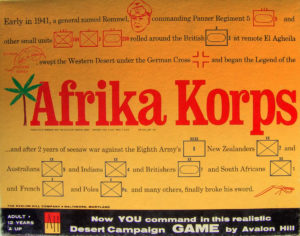
The first release of Afrika Korps. It’s telling that the game is named after Rommel’s army in North Africa, not the Allied one.
In the same year that The Rommel Papers were published, a correspondent for The Irish Times attended an odd museum exhibition in London that was devoted to Rommel’s exploits. He wrote the following afterward:
One fact was impressed upon me: that there is a strategy of warfare which, for the devotees, has little to do with blood and horror and death. The maps were being scrutinized like precious works. There was the impression that war was an enthralling game, like cricket. Viewing Rommel in this sense, I concluded that I had as much right to make a judgment as a professional footballer at a modern-art exhibition.
If military history approached war as a metaphorical game, then why not turn it into a literal game? After all, what could be better for a military-history buff than to live out the conflicts that had heretofore existed only within the pages of his books and try out alternate strategies? In 1954, Charles S. Roberts published a board game called Tactics through his new Avalon Hill Game Company. The canonical first commercial wargame ever, it depicted warfare in a somewhat abstracted, non-historical context. But six years later, Roberts and his company surfaced again with Gettysburg, the first wargame to engage with an historical conflict. Going forward, not all readers of military history would be wargamers, but all wargamers would be readers of military history.
Avalon Hill released a steady trickle of games over the next few years, most of them depictions of other battles of the American Civil War, the only conflict that even approached the popularity of the Second World War among American military-history readers. But by 1964 sales figures were trending in the wrong direction. Seeking to reverse the slide, Roberts shifted his focus to World War II, designing what would prove to be one of his company’s biggest and most iconic games of all.
As the name would imply, Afrika Korps dealt with the North African theater of the war, giving armchair generals a chance to step into the smartly shined boots of Erwin Rommel: “Now the legend of the Desert Fox is recreated!” trumpeted the box text. The game established several precedents. First, it made the North African front into a perennial favorite with wargamers for the same reasons that it was so popular with military-history authors and their readers: its wide-open terrain and the resulting room for tactical maneuvering, and its supposedly sporting, gentlemanly nature. Second, it taught many who played it that the Germans were simply cooler: they had better technology, better esprit de corps, even better uniforms than the stodgy Allies to offset their generally inferior numbers. And finally, it introduced the wargame cliché of the “Rommel unit”: a unit whose commander is such a superhero that he can break the rules that usually govern the game by sheer force of will. As a whole, notes Joseph Allen Campo in his recent PhD thesis on cultural perceptions of Rommel, “the focus on Rommel and more generally the German side (many wargames feature prominent German military motifs and use German military nomenclature) cater to a genre that customarily finds more interest in playing the underdog, relying on [the player’s] brains rather than overwhelming force, and accepting the challenge of reversing the historical result.”
Coincidentally or not, tabletop wargaming grew in popularity by leaps and bounds after the release of Afrika Korps. At its peak in 1980, the industry sold 2.2 million games.
I hope that the chain of causation and influence which brought us Panzer General thirty years after Afrika Korps is becoming clear by now. I won’t belabor it unduly, given that I’ve already told most of the story in other articles. Suffice to say that in 1979 an avid young tabletop wargamer named Joel Billings decided to found a company to bring his hobby to the personal computers that were just entering the marketplace at that time. That company, which Billings called Strategic Simulations, Incorporated, specialized in digital wargames for much of its existence, and was the very same one which brought Panzer General to store shelves in 1994.
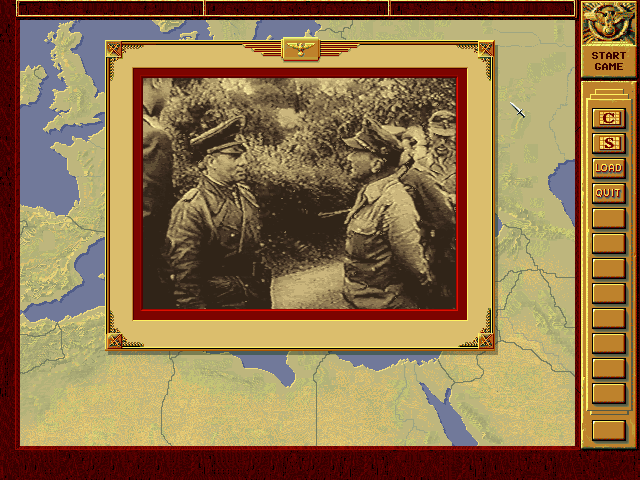
The gallant panzer general gets his orders. (How can you argue with cool uniforms like these?) The game studiously avoids swastikas. In popular culture, the swastika has come to stand for the Gestapo, SS, and other “bad” Nazis, while the older iconography of the Iron Cross or eagle wings stands in for the “clean” Wehrmacht. But the real distinction is, as we’ve seen, less clear-cut than many would like it to be.
Erwin Rommel is never mentioned by name in Panzer General, but his larger-than-life persona of legend is stamped all over it. He is, after all, the personification of the Wehrmacht as wargamers know it — not as barbaric invaders and espousers of a loathsome racist creed which they are all too eager to use to justify genocide, but as clever, audacious, courageous warriors with great fashion sense and all the best kit. Afrika Korps: “You can re-create Field Marshall Rommel’s daring exploits at Bengasi, Tobruk, El Alamein, and points in between!” Panzer General:
Imagine that you are the Panzer General. You are the brightest and best of the new Axis generals in the Second World War. Go from triumph to triumph, invading and seizing the capitals of Great Britain, the Soviet Union, and ultimately the United States of America on your way to conquering the whole world!
In terms of the broader culture — the one that doesn’t tend to read a lot of military history or play a lot of wargames — Panzer General was already an anachronism in 1994. In 1960, the American journalist William L. Shirer had published The Rise and Fall of the Third Reich, which over the course of its 1200-plus pages documented in meticulous detail exactly what the Nazi regime had done and how it had done it. Close on that book’s heels, the capture and trial of Holocaust administrator Adolf Eichmann in an Israeli court consumed the world’s attention much as the Nuremberg trials had a decade and a half previously — only now television brought the proceedings, and the atrocities they documented, to a much more visceral sort of light. In West Germany, the student activism of the hippie era, accompanied by the election of a social-democratic chancellor who was less beholden to the tradition of forgetfulness, finally pushed the country toward a proper reckoning with its past. A spate of unsparing books, films, and even museums about the Holocaust and the other crimes of the Nazi regime appeared in West Germany and elsewhere in the years that followed, fully acknowledging for the first time the complicity of those Germans who weren’t in Hitler’s inner circle. A new understanding became palpable among Germans: that they couldn’t escape from their past by denying guilt and wishing atrocities away; that the only way to ensure that something like the Third Reich never took root again was to examine how they themselves or their parents, living in a nation as civilized as any other in Europe, could have been tempted down such a sickening path.
These developments were as welcome as they were necessary, both for Germans and for all of the other citizens of the world. Yet Panzer General and the cultural milieu that had spawned it remained caught in that strange interregnum of the 1950s, as do most of the wargames of today.
So, having now a reasonable idea of how we got to this place where patriotic Americans bought a game in which they played the role of genocidal foreign conquerors of their country’s capital, it’s up to each of us to decide how we feel about it. What sorts of subject matter are appropriate for a game? Before you rush to answer, ask yourself how you would feel about, say, a version of Transport Tycoon where you have to move Jews from the cities where they live to the concentration camps where they will die. If, as I dearly hope, you would prefer not to play such a game, ask yourself what the differences between Panzer General and that other game really are. For your actions in Panzer General will also lead to the deaths of millions, at only one more degree of remove at best.
Or am I hopelessly overthinking it? Is Panzer General just a piece of harmless entertainment that happens to play with a subset of the stuff of history?
It’s a judgment call that’s personal to each of us. For my part, I can play the German side in a conventional wargame easily enough if I need to, although I would prefer to take the Allied side. But Panzer General, with its eagerness to embed me in the role of a German general goose-stepping and kowtowing to his Führer, is a bridge too far for me. I would feel more comfortable with it if it made some effort to acknowledge — even via a footnote in the manual! — the horrors of the ideology which it depicts as all stirring music and proudly waving banners.
Before I attempt to say more than that, I’d like to look at another game released the same year as Panzer General, designed by a veteran of the same wargaming culture that spawned SSI. It takes place in a very different historical milieu, but leaves us with some of the same broad questions about the ethical obligations — or lack thereof — that come attached to a game that purports to depict real historical events.
(Sources: the books Adenauer’s Germany and the Nazi Past by Norbert Frei, Divided Memory: The Nazi Past in Two Germanys by Jeffrey Herf, War Stories: The Search for a Usable Past in the Federal Republic of Germany by Robert G. Moeller, Rommel: The Desert Fox by Desmond Young, The Rommel Papers by B.H. Liddell Hart, In Hitler’s Shadow by Richard J. Evans, Legacies of Dachau: The Uses and Abuses of a Concentration Camp, 1933-2001 by Harold Marcuse, Blood, Tears, and Folly: An Objective Look at World War II by Len Deighton, War Without Hate: The Desert Campaign of 1940-43 by John Bierman and Colin Smith, The Real War (1914-1918) by B.H. Liddell Hart, Uncovering the Holocaust: The International Reception of Night and Fog by Ewout van der Knaap, and The Complete Wargames Handbook by James F. Dunnigan. But my spirit guide and crib sheet through much of this article was Joseph Campo’s superb 2019 PhD thesis for UC Santa Barbara, “Desert Fox or Hitler Favorite? Myths and Memories of Erwin Rommel: 1941-1970.”)
